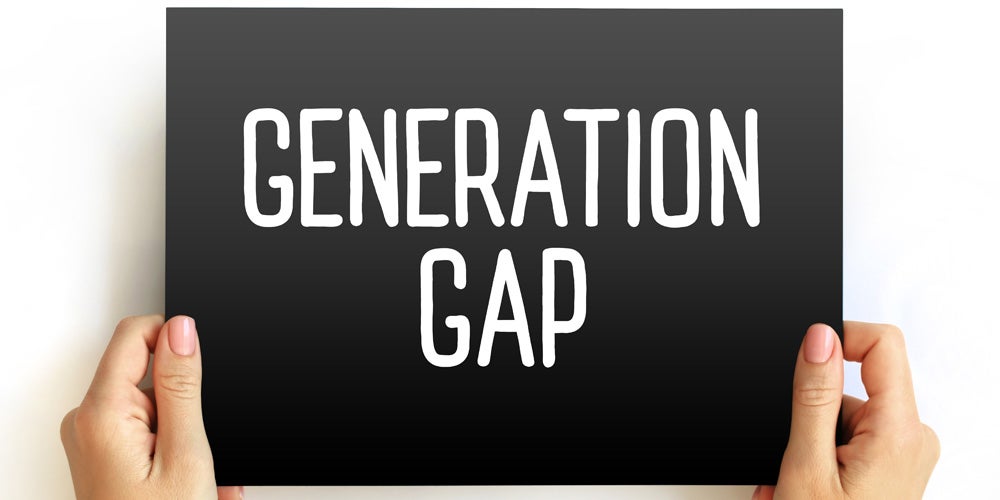
Today’s reality within the workplace includes a generational gap, which refers to the differences in attitudes, values, and behaviours between older and younger employees.
While this blend offers a rich pool of perspectives, it also introduces challenges in communication and collaboration. Spanning across Baby Boomers to Generation Z, each group brings its own set of values, problem-solving tactics, work ethics, and communication styles.
For managers who find themselves at the intersection of leading both younger and older teams, recognising and effectively managing this diversity is crucial. So, let’s look into the intricacies of the generational gap, exploring its impact on workplace harmony and look into actionable strategies to leverage the strengths of each generation.
Is the Generational Gap a Workplace Challenge?
The generational gap in the workplace is not just a buzzword; it's a significant issue that can impact organisational culture, employee retention, and productivity. In fact, according to research by the American Psychological Association, generational conflicts and clashes are likely to occur when people are working in teams.
These generational clashes are often cited as reasons for job dissatisfaction and, in some cases, may contribute to talented employees leaving the company. Nevertheless, in a survey by the Living, Learning, and Earning Longer Collaborative Initiative, more than 8 in 10 global leaders recognise that multigenerational workforces are key to business growth and success ⸺ which is why it’s crucial to understand these generational differences.
Understanding Generational Differences
Each generation brings its unique set of values, work ethics, and expectations to the workplace:
| Baby Boomers | Generation X | Millennials | Generation Z |
|
|
|
|
-
Baby Boomers (born 1946–1964) are often characterised by their strong work ethic, loyalty, and preference for face-to-face communication.
-
Generation X (born 1965–1980) values independence, work-life balance, and is known for being the first to bring a tech-savvy perspective to the workplace.
-
Millennials (born 1981–1996) prioritise meaningful work, flexibility, and are adept at digital communication.
-
Generation Z (born 1997–2012) values authenticity, innovation, and is highly comfortable with technology and social media.
While these descriptions can provide a broad understanding, it's important to approach each team member as an individual rather than relying solely on generational stereotypes.
Navigating the Generational Gap: Common Challenges
As leaders and managers strive to foster a cohesive and productive work environment, understanding the common issues is the first step toward bridging the divide.
Here are some prevalent problems that arise from the generational gap:
-
Diverging communication styles: Older generations (Baby Boomers and Gen X) favour traditional methods like face-to-face meetings and phone calls, while younger generations (Millennials and Gen Z) opt for digital means, including emails and instant messaging. These differences can lead to misunderstandings and disconnect, while also challenging team cohesion.
-
Conflicting work-life balance expectations: Work-life balance priorities vary significantly across generations. Millennials and Gen Z often seek flexibility, such as remote work as an essential for balance, whereas Baby Boomers and Gen X may prioritise clear boundaries between professional and personal life, preferring traditional office settings. This disparity in expectations can cause tension, with perceptions of commitment and work ethic at stake.
-
Varied attitudes towards authority and hierarchical structures: Generational differences also manifest in perceptions of authority and organisational structure. Younger generations lean towards egalitarian and collaborative environments, where ideas are freely shared. This contrasts with older generations' preference for defined hierarchical structures. This clash can complicate management and team relations.

3 Ways to Manage the Generational Gap
1. Embrace Generational Diversity
Viewing generational diversity as an asset rather than a hindrance can significantly benefit your team. Diverse age groups bring varied perspectives, skills, and experiences to the table, enhancing creativity and problem-solving.
Encouraging cross-generational mentorship and giving younger employees leadership opportunities can foster a culture of learning and respect. Recognising the value of each generation's contributions can lead to a more inclusive and productive workplace.
- Example: A technology firm implements a "Reverse Mentoring" programme where Gen Z employees mentor Baby Boomers on the latest digital marketing trends, while the Boomers share their extensive knowledge on strategic planning and client management.
2. Foster Curiosity, Inclusion, and Empathy
Promoting an environment of open communication and understanding is key to bridging the generational divide. Encourage team members to step beyond stereotypes and assumptions, fostering curiosity about each other's experiences and viewpoints.
Tailoring communication and work styles to meet the needs and preferences of all team members can enhance collaboration and efficiency. By acting as a mentor to younger employees and learning from the experiences of older colleagues, managers can build a culture of mutual respect and knowledge sharing.
-
Example: A multinational corporation introduces "Cultural Exchange Lunches" where team members from different generations and backgrounds share their personal stories and cultural experiences over a meal.
3. Create a Shared Goal to Overcome Generational Barriers
Uniting your team around common objectives can help minimise the focus on age-related differences. Encouraging the acknowledgment of generational gaps and viewing them as opportunities for growth can foster a sense of shared purpose.
By facilitating open dialogue about age-related issues and encouraging collaboration, leaders can help build stronger and more cohesive teams. Empowering all team members to share their strengths and perspectives not only bridges the generational gap but also contributes to a more dynamic and innovative workplace.
-
Example: A software development company facing challenges in project delivery timelines sets a company-wide objective to enhance product development efficiency through cross-generational collaboration. Teams are encouraged to form project groups that include members from every generation, working together to find innovative solutions.
A multi-generational team is like a toolbox—each tool has a unique function, but together they build success.
Embrace the Gap
Managing the generational gap in the workplace requires a strategic and empathetic approach. By embracing diversity, fostering open communication, and uniting the team around shared goals, managers can create an environment where all generations feel valued and engaged.
In doing so, they not only enhance productivity and retention but also build a workplace culture that is resilient, inclusive, and poised for success in an ever-evolving business landscape.
Additionally, continuous learning and professional development equip leaders to adeptly navigate the complexities of a diverse workplace, enhance their ability to address challenges, and harness the potential of generational diversity.
If you are interested in upskilling, check out HELP University's MBA Online programme which offers distinct advantages for the professional needs of managers and leaders. Reach out for a free consultation with our dedicated Education Counsellors now.
